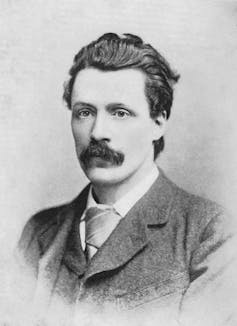Coercive or controlling behaviour in an intimate or family relationship became a criminal offence in the UK in December 2015. The legislation was the result of a long campaign by the charity Women’s Aid to extend understanding of domestic abuse beyond physical violence. But, over 150 years earlier, Emily Brontë placed coercive control at the heart of her celebrated gothic romance, Wuthering Heights.
The novel is often read as a great love story. It has inspired a Kate Bush song and many stage, film and TV adaptations. But Heathcliff is an abused child who becomes an abuser – and teaches his son to copy, continue and refine his abuse.
In the novel, Cathy declares that “My love for Heathcliff resembles the eternal rocks beneath: a source of little visible delight, but necessary. Nelly, I am Heathcliff!” Coercive control, like Cathy’s love, may not be fully visible, but it nonetheless underpins the emotional logic of Brontë’s plot.
This article is part of Rethinking the Classics. The stories in this series offer insightful new ways to think about and interpret classic books and artworks. This is the canon – with a twist.
Wuthering Heights is a novel of two halves. The first focuses on spirited, passionate Cathy, caught between her tamely domestic husband Edgar Linton and the thrilling wildness of Heathcliff, her soulmate from childhood. To revenge himself on Cathy for marrying Edgar, Heathcliff elopes with Edgar’s infatuated sister Isabella. Isabella initially sees Heathcliff as a brooding romantic hero, but she soon repents, fleeing with their baby son Linton.
Heathcliff’s abuse of Isabella is sometimes physical, but more often psychological. He takes care, as he tells the family servant Nelly Dean, to “keep strictly within the limits of the law” to avoid giving Isabella “the slightest right to claim a separation”.
The law grants him ownership of his wife’s money and property, but subtler refinements of abuse include humiliation, isolation from family and friends, and deprivation of food, privacy and personal care. At Wuthering Heights, Nelly is shocked to see Isabella unwashed, shabbily dressed. She’s “wan and listless; her hair uncurled: some locks hanging lankly down”.
Isabella has already reported that she is forced to sleep in a chair because Heathcliff keeps “the key of our room in his pocket”. Heathcliff delights in humbling her before Nelly and his own servants, calling her “an abject thing”, “shamefully cringing”, “pitiful, slavish, and mean-minded”.
Isabella escapes Heathcliff clad only in “a girlish dress” and “thin slippers”, and goes into hiding with her brother’s financial help. After her death, Heathcliff recovers their son Linton and uses him to engineer a second coercive marriage to his cousin, Cathy and Edgar’s daughter Catherine.
A sickly, peevish adolescent, Linton Heathcliff is perhaps the most unappealing character in Victorian fiction, lacking altogether the strength and charisma of his father. But his puny physicality casts the coercive nature of his abuse into relief.
Catherine is imprisoned at Wuthering Heights and blackmailed into consenting to marry Linton, who becomes the legal owner of all her property. Incapable of dominating her physically, Linton delights in psychological torment, conspiring in his father’s surveillance and depriving her of beloved possessions:
All her nice books are mine; she offered to give me them, and her pretty birds, and her pony Minny, if I would get the key of our room, and let her out; but I told her she had nothing to give, they were all, all mine. And then she cried, and took a little picture from her neck, and said I should have that; two pictures in a gold case, on one side her mother, and on the other uncle [Catherine’s father], when they were young. That was yesterday – I said they were mine, too.
After Linton’s death, Heathcliff inherits everything, leaving the widowed and orphaned Catherine his penniless dependant. Wuthering Heights is a dark parable about the absolute power that marriage can grant to abusive men.
Real-life inspiration
Brontë’s plot was rooted in a real-life local case of domestic torment. In 1840, a Mrs Collins came to Haworth Parsonage to ask Emily’s father Patrick’s advice about her alcoholic, abusive husband. He was Patrick’s colleague and fellow clergyman, Rev. John Collins, assistant curate of Keighley.
Unusually for the time, Patrick advised her to leave him and take her two children with her. In April 1847, just seven months before Wuthering Heights’ publication, Mrs Collins returned to Haworth to thank him. She told the Brontë family how she had settled in Manchester with her children, supporting them all by running a lodging house.
Looking for something good? Cut through the noise with a carefully curated selection of the latest releases, live events and exhibitions, straight to your inbox every fortnight, on Fridays. Sign up here.
Mrs Collins’ experience of abuse did not only shape the chilling psychodrama of Wuthering Heights. There are echoes of Patrick’s advice in Emily’s sister Charlotte’s novel Jane Eyre (1847), and her eponymous heroine’s famous declaration of autonomy: “I am no bird; and no net ensnares me; I am a free human being with an independent will, which I now exert to leave you.”
Mrs Collins’ strength and resilience also inspires the bravery of Helen Huntingdon in Anne’s The Tenant of Wildfell Hall (1848). Like Emily’s “eternal rocks,” coercive control lurks beneath the Brontës’ best-loved fictions, warning Victorian readers of the terrifyingly real dangers of psychological abuse long before the law caught up.
Beyond the canon
As part of the Rethinking the Classics series, we’re asking our experts to recommend a book or artwork that tackles similar themes to the canonical work in question, but isn’t (yet) considered a classic itself. Here is the suggestion from Hannah Roche and Katy Mullin:

Like the Brontës’ famous novels, George Gissing’s The Odd Women (1893) shows an acute awareness of the impact of psychological abuse. Against her better judgement, the 21-year-old Monica Madden marries Edmund Widdowson, a man 23 years her senior who attempts to police every aspect of her domestic, social, intellectual and psychological life.
Gissing’s fictional abuser is a classic coercive controller, a perpetrator of a crime that did not yet exist, and his pattern of behaviour is now so familiar and identifiable that it appears both prescient and predictable. Intensely jealous and possessive, Widdowson deploys tactics of surveillance, stalking, regulation and isolation, making decisions about where Monica goes, who she sees, and even what she reads.
Of course, like Heathcliff and Linton, Widdowson does not have access to online communication tools or spyware. But the many red flags in his treatment of Monica are likely to appear strikingly modern to readers today.
Katy Mullin receives funding from the Arts and Humanities Research Council ("Coercive Control: From Literature into Law", an AHRC Research Network).
Hannah Roche receives funding from the Arts and Humanities Research Council ("Coercive Control: From Literature into Law", an AHRC Research Network).
This article was originally published on The Conversation. Read the original article.







